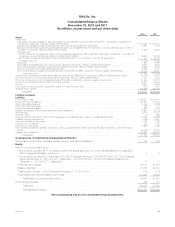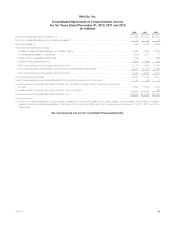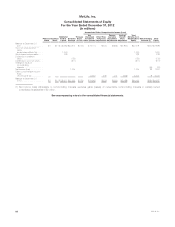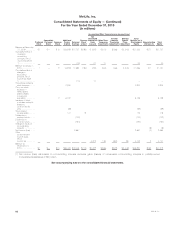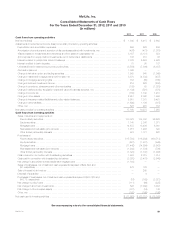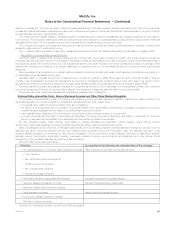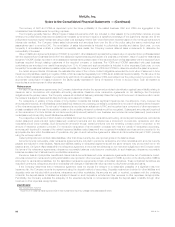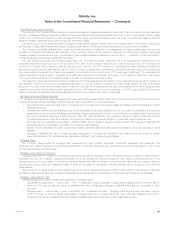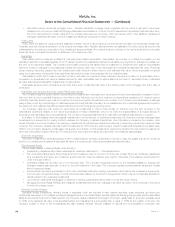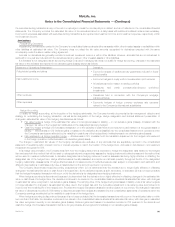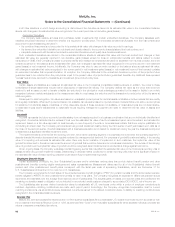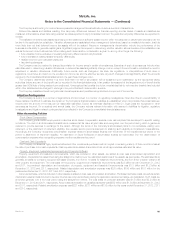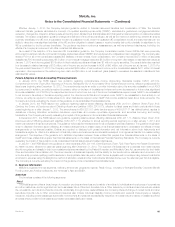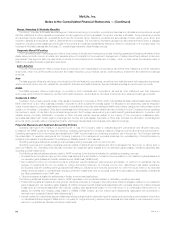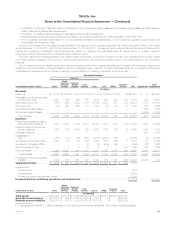MetLife 2012 Annual Report Download - page 93
Download and view the complete annual report
Please find page 93 of the 2012 MetLife annual report below. You can navigate through the pages in the report by either clicking on the pages listed below, or by using the keyword search tool below to find specific information within the annual report.
MetLife, Inc.
Notes to the Consolidated Financial Statements — (Continued)
claims by business line. The methods used to determine these estimates are continually reviewed. Adjustments resulting from this continuous review
process and differences between estimates and payments for claims are recognized in policyholder benefits and claims expense in the period in which
the estimates are changed or payments are made.
The unearned revenue liability relates to universal life-type and investment-type products and represents policy charges for services to be provided in
future periods. The charges are deferred as unearned revenue and amortized using the product’s estimated gross profits and margins, similar to DAC as
discussed further herein. Such amortization is recorded in universal life and investment-type product policy fees.
The Company accounts for the prepayment of premiums on its individual life, group life and health contracts as premium received in advance and
applies the cash received to premiums when due.
See “— Deferred Policy Acquisition Costs, Value of Business Acquired and Other Policy-Related Intangibles” for a discussion of negative VOBA.
Recognition of Insurance Revenues and Deposits
Premiums related to traditional life, annuity policies with life contingencies, long-duration accident and health, and credit insurance policies are
recognized as revenues when due from policyholders. Policyholder benefits and expenses are provided to recognize profits over the estimated lives of
the insurance policies. When premiums are due over a significantly shorter period than the period over which benefits are provided, any excess profit is
deferred and recognized into earnings in a constant relationship to insurance in-force or, for annuities, the amount of expected future policy benefit
payments.
Premiums related to short-duration non-medical health and disability, accident and health, and certain credit insurance contracts are recognized on a
pro rata basis over the applicable contract term.
Deposits related to universal life-type and investment-type products are credited to PABs. Revenues from such contracts consist of fees for
mortality, policy administration and surrender charges and are recorded in universal life and investment-type product policy fees in the period in which
services are provided. Amounts that are charged to earnings include interest credited and benefit claims incurred in excess of related PABs.
Premiums related to property and casualty contracts are recognized as revenue on a pro rata basis over the applicable contract term. Unearned
premiums, representing the portion of premium written related to the unexpired coverage, are also included in future policy benefits.
Premiums, policy fees, policyholder benefits and expenses are presented net of reinsurance.
Deferred Policy Acquisition Costs, Value of Business Acquired and Other Policy-Related Intangibles
The Company incurs significant costs in connection with acquiring new and renewal insurance business. Costs that are related directly to the
successful acquisition or renewal of insurance contracts are capitalized as DAC. Such costs include:
‰incremental direct costs of contract acquisition, such as commissions;
‰the portion of an employee’s total compensation and benefits related to time spent selling, underwriting or processing the issuance of new and
renewal insurance business only with respect to actual policies acquired or renewed;
‰other essential direct costs that would not have been incurred had a policy not been acquired or renewed; and
‰in limited circumstances, the costs of direct-response advertising, the primary purpose of which is to elicit sales to customers who could be
shown to have responded specifically to the advertising and that results in probable future benefits.
All other acquisition-related costs, including those related to general advertising and solicitation, market research, agent training, product
development, unsuccessful sales and underwriting efforts, as well as all indirect costs, are expensed as incurred.
Value of business acquired (“VOBA”) is an intangible asset resulting from a business combination that represents the excess of book value over the
estimated fair value of acquired insurance, annuity, and investment-type contracts in-force at the acquisition date. The estimated fair value of the
acquired liabilities is based on projections, by each block of business, of future policy and contract charges, premiums, mortality and morbidity,
separate account performance, surrenders, operating expenses, investment returns, nonperformance risk adjustment and other factors. Actual
experience on the purchased business may vary from these projections.
DAC and VOBA are amortized as follows:
Products: In proportion to the following over estimated lives of the contracts:
‰Non-participating and non-dividend-paying traditional contracts: Historic actual and expected future gross premiums.
‰Term insurance
‰Non-participating whole life insurance
‰Traditional group life insurance
‰Non-medical health insurance
‰Accident and health insurance
‰Participating, dividend-paying traditional contracts Actual and expected future gross margins.
‰Fixed and variable universal life contracts Actual and expected future gross profits.
‰Fixed and variable deferred annuity contracts
‰Credit insurance contracts Historic and future earned premium.
‰Property and casualty insurance contracts
‰Other short-duration contracts
See Note 5 for additional information on DAC and VOBA amortization.
MetLife, Inc. 87


